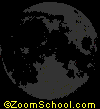 | The Phases of the Moon | Label the Moon Phases |
As the moon circles the Earth, the shape of the moon appears to change; this is because different amounts of the illuminated part of the moon are facing us. The shape varies from a full moon (when the Earth is between the sun and the moon) to a new moon (when the moon is between the sun and the Earth).
Definitions:
BLUE MOON When two full moons occur in a single month, the second full moon is called a "Blue Moon." Another definition of the blue moon is the third full moon that occurs in a season of the year which has four full moons (usually each season has only three full moons.) | CRESCENT MOON A crescent moon is part way between a half moon and a new moon, or between a new moon and a half moon. |
FULL MOON A full moon appears as an entire circle in the sky. The full moon is given different names, depending on when it appears. For example, the "Harvest moon" is the full moon that appears nearest to the Autumnal Equinox, occurring in late September or early October. Some other full moon names (by month) include: January Moon After Yule, Wolf Moon, or Old Moon |
The moon rises and sets every day, appearing on the horizon just like the sun. The time depends on the phase of the moon. It rises about 30 to 70 minutes later each day than the previous day, so the moon is out during daytime as often is it's out at night. At the time of the new moon, the moon rises at about the same time the sun rises, and it sets at about the same time the sun sets. As the days go by (as it waxes to become a crescent moon, a half moon, and a gibbous moon, on the way to a full moon), the moon rises during daytime (after the sun rises), rising later each day, and it sets at nighttime, setting later and later each night. At the full moon, the times of moonrise and moonset have advanced so that the moon rises about the same time the sun sets, and the moon sets at about the same time the sun rises. As the moon wanes (becoming a half moon and a crescent moon, on the way to a new moon), the moon rises during the night, after sunset, rising later each night. It then sets in the daytime, after the sun rises. Eventually, the moon rises so late at night that it's actually rising around sunrise, and it's setting around sunset. That's when it's a new moon once again.
No comments:
Post a Comment